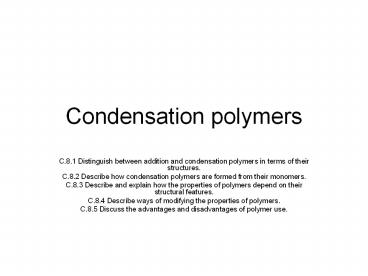Condensation polymers - PowerPoint PPT Presentation
1 / 16
Title:
Condensation polymers
Description:
Condensation polymers C.8.1 Distinguish between addition and condensation polymers in terms of their structures. C.8.2 Describe how condensation polymers are formed ... – PowerPoint PPT presentation
Number of Views:524
Avg rating:3.0/5.0
Title: Condensation polymers
1
Condensation polymers
- C.8.1 Distinguish between addition and
condensation polymers in terms of their
structures. - C.8.2 Describe how condensation polymers are
formed from their monomers. - C.8.3 Describe and explain how the properties of
polymers depend on their structural features. - C.8.4 Describe ways of modifying the properties
of polymers. - C.8.5 Discuss the advantages and disadvantages of
polymer use.
2
Distinguish between addition polymer and
condensation polymer
- Addition polymer
- formed by an addition reaction, where many
monomers bond together via rearrangement of bonds
without the loss of any atom or molecule. - Usually made from alkenes
- Condensation polymer
- formed by a condensation reaction where a
molecule, usually water, is lost during the
formation - Made from monomers that contain at least two
reactive functional groups( or same functional
group at least twice)
3
Formation of polyester
- Polyethen terephthalate (PET)
- When benzene-1,4-dicarboxylic acid and ethane-1,2
diol reacts
4
Phenol-methanal plastic
- The reaction is a condensation polymerisation in
which water is eliminated as a hydrogen atom from
the benzene ring of each of two neighbouring
phenol molecules combines with the oxygen atom
from a methanal molecule ( When acid or alkali is
added to the mixture of phenol and methanal) - The remaining CH2 group from the methanal
molecule then forms a bridge between two
neighbouring phenol molecules. This process,
repeated many thousands of times, forms chains of
phenol and methanal molecules linked in this way.
5
Mechanism
- When acid or alkali is added to the mixture of
phenol and methanol. - Methanal is substituted in the 2- or 4- position
in the phenol - It then undergoes a condensation reaction with
another phenol molecule.
6
Long Chain
- Long chain of phenol-methanal plastics (covalent
cross linking three dimensional structure) is
built up when further polymerization takes place
7
Formation of Polyurethane
- When polyhydric alcohols (e.g. diols or triols)
reacts with compounds containing more than one
isocyanate functional group, -NCO will produce
polyurethanes.
8
Polyurethane
- Polyurethanes are somehow considered as addition
polymers since there is no small molecules formed
during the reaction. However there is no urethane
monomers that add together to form polyurethanes. - Polyurethanes are made in situ and moulded into
shape wanted. - (In the reaction mixture." There are numerous
unstable molecules which must be synthesized in
situ (i.e. in the reaction mixture but cannot be
isolated on their own )
9
Properties of polymers
- Properties of condensation polymers depend on
their structures. - The benzene ring bonds in more than one position
of phenol-methanal plastics forms 3-D
cross-linked structure
10
Properties
- The structure gives high strength. Therefore the
compound is - High melting point ( decompose before melting)
- Unreactive
- High electrical resistance
- It can be use as an ingredient in worktops and
printed-circuit-board insulation - Before it was use as the casing for radios
11
Kevlar
- Kevlar is a polyamide
- It forms when 1,2-diaminobenzene
(paraphenylenediamine) condenses with
benzene-1,4-dicarbonyl chloride(terephthaloyl
dichloride)
12
Long chain
- Further polymerization forms a strong
three-dimensional structure because of the
hydrogen bonding between the long rigid chain - Kevlar is used to produce lightweight
bullet-proof vest, composites for motor-cycle
helmets and amour.
13
Modification of polymers
- Apart from adding plasticizers (covered in
addition polymer) there are 3 more ways to modify
polymers - Blowing air into polyurethane to make
polyurethane foams ( cushions and thermal
insulator) - Blending fibres of polyesters (PET) with other
manufactured or natural fibres to make clothes
become dye-fast and comfortable than pure
polyesters.
14
Modifying polymer
- Another way is adding chemicals ( this process is
called doping polymer) such as - Iodine which removes electrons
- or
- Alkali metals which adds electrons
- When ethyen is polymerized, the cis-form of
polyethene is a electrical conductor due to the
deloclization of the pi electrons. - The conductivity is increaseddramatically after
doping I2
15
Advantages
- Use to produce lightweight bullet-proof vest,
composites for motor-cycle helmets and amour.
(PET) - Devices such as billiard balls, dominoes,
Mahjongg tiles and other gaming tilesets, and
movers/pieces for games like chess, checkers, and
backgammon, are constructed of Bakelite(phenol-met
hanal plastics) for the look, durability, fine
polish, weight, and sound of the resulting pieces - Polyurethane products have many uses. Over three
quarters of the global consumption of
polyurethane products is in the form of foams,
with flexible and rigid types being roughly equal
in market size. In both cases, the foam is
usually behind other materials flexible foams
are behind upholstery fabrics in commercial and
domestic furniture rigid foams are inside the
metal and plastic walls of most refrigerators and
freezers, or behind paper, metals and other
surface materials in the case of thermal
insulation panels in the construction sector.
16
Disadvantages
- The disadvantages of condensation polymer are
similar to addition polymer - Low-reactivity ? Not easy to dispose off.
- Generally not biodegradable
- Produce hydrogen cyanide gas when polyurethanes
are burned.































